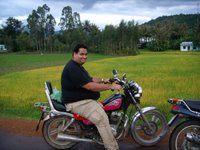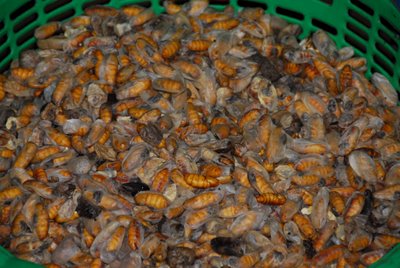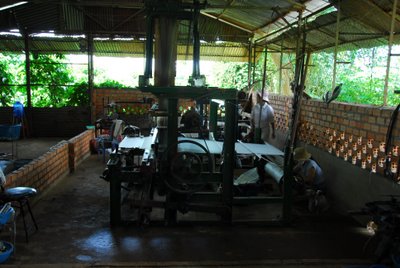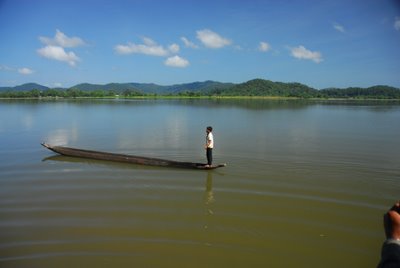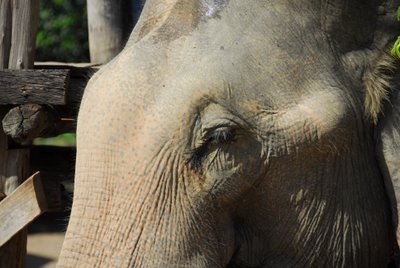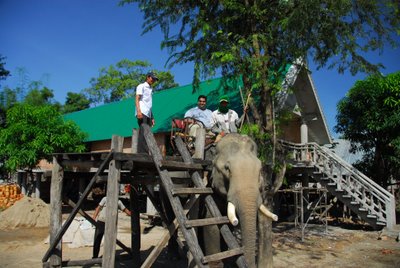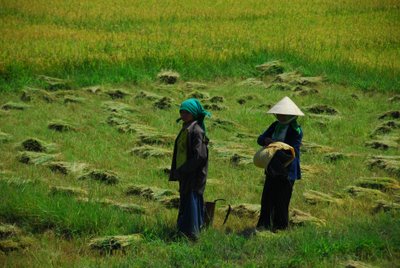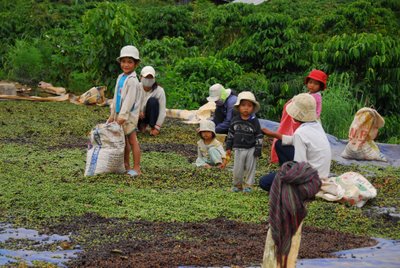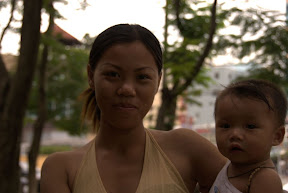Oct 13-17
Though these are not sorted or organized in any way, I've uploaded some photos to the following album. A much cleaner version will come once I'm back home.
Also note the movies throughout this entry.
Internet in Developing Countries - Audition
Stuart asked how I maintain this blog and whether I carry a laptop with me.
My bag is heavy enough as it is and the equipment I carry is expensive enough that a laptop would just have been a burden.The tools of the trade:
- One Nikon D200 SLR digital camera with an 18-200 lens and a few accessories. (this is the first long trip I haven't carried a tripod with me though)
- One Nikon Coolpix S9 pocket digital camera - I bought this as a backup camera after the painful lesson of having my previous lens stolen, though it turned out great for shooting movies and for carrying with me unobtrusively at night when walking around town.
- One iPod with a digicam connector attachment - great for music but even better as a storage device for the digital photos. At night, I hook the cameras up to it, copy everything over and reformat the cards.
As for Internet access - I've found that a lot of the developing countries are creating a new model for it. In countries as poor as Guatemala, Vietnam, Cambodia and Bolivia, you'd find Internet stores (not cafes) sprinkled all over the place. At first you might imagine they are for tourists to use for email and cheap internet phone calls, but that's only part of the story. People here are too poor to have an Internet connection, let alone buy their own PC.The solution: Internet stores. A small store having multiple PCs, all connected to the net (hopefully through DSL though not always).
The uses: the young generation uses it the most. Kids play networked games against each other. On a weekend, these places are packed with barely a room to move - this is the new hangout.In most places I've seen the boys were playing war games, killing each other over the net, while the girls were either using chat or else playing a game called Audition, a networked version of Dance Dance Revolution. Girls sitting at different computers would compete at typing in the right sequence of key presses to make their avatar, usually hip US-style kids, dance and twirl on the screen. But then in Playcu I came into the store and saw the boys playing that too. I guess it crosses gender boundaries well enough.
Internet stores are available almost anywhere. On the last night of the motorcycle trip, we stopped in a little town that barely had a small hotel. I asked my guide if there was an Internet store around and he said no. I convinced him to ask the locals and of course there was. We went in and, this being a small town, I became an even bigger celebrity than usual. Though they could not speak with me, they surrounded me and discussed me to death. At a certain point I got so fed up I turned on the camera and twisted it over my head to catch them all around me.
Day 3 - Boun Ma Thuot to Playcu– 185 km
Riding a motorcycle is the closest I've come to experience free flight. The only things that interfere with your field of vision are the handle bars. The road passes by you and you can easily select how quickly. To move left or right you need only apply a bit of pressure and the bike accommodates you. It's an amazing feeling when you see the road passing under you. The only thing you can't do is go up :)
Riding a motorcycle is like, well..., riding a bike. You never forget. But there are things you need to bring up from long term memory's vault. One is the proper time to switch gears. Yes - it's a manual bike. The other is the proper way of doing it. Gears in motorcycles are switched with the foot while the clutch is hand-operated.
The Honda I drove for a day had a cyclical gear mechanism - you nudge the gear lever with your foot down and progress through 1st -> 2nd -> 3rd -> 4th -> neutral -> back to 1st. You can also kick up but why bother. The Daelim I was riding for the long 5 day trip had a linear gear mechanism - kick up to progress 1 -> 2 -> 3 -> 4, and down to go back. Neutral is somewhere between 1st and 2nd if you have a sensitive enough foot.
Once you realize how your motorcycle behaves, you can get more out of it - you learn how fast you can go with 2nd and when the right time to switch to 3rd is. 4th is not really that useful in this area - you rarely get up to those speeds. I also learned that my guide was going slowly on purpose. He was saying "we have time, ride slow, enjoy the day" at the same time as he was telling me he rides the full 5 days' trail back in 1 day. He was not really catching on to the fact that my ass was taking a beating.
So I finally just passed him and set the speed. I quickly realized that once I do that, he just follows at my own speed and passes me when he wants me to stop or if I go too slowly. We've reached speeds of 50kmh (30mph) on day 3! I know it's not the sound barrier but I was very happy.
Kid Magnet
Our goal for day 3 was a city called Playcu. There's nothing really to see in Playcu, but my guide's mother was sick and in the hospital and that's his home town, so I agreed to stop there, about 20 km before our originally planned destination. From time to time I'd stop to take a picture or just to get off the bike and stretch my legs. One such unplanned stop was at a nowhere village along the road. Calling it a village is overstating it. We're talking about a handful of shacks along the main road.
Phu (my guide) took my camera and crossed the road in order to take a photo of Eran, the great explorer, with the bike. Within 20 seconds I was surrounded by girls who came out of nowhere to stand next to me and be in the photo. The boys, apparently more shy, took a bit more time to come out.
Bubble Gum Does Grow on Trees
Leaving Buon Ma Thuot, the the view changes. We were traveling through a more sparsely populated section of the road. Few villages were sprinkled along it, but most of the vegetation is either forests or rubber plantations. We stopped by one of these to see what it looks like. The people were very friendly and let us go into the forest where you can see endless rows of rubber trees. The rubber is harvested by slashing the trunk of the tree and hanging a little bowl to collect the rubber that flows out.
Then the rubber is put into buckets and left to condense a bit to get a less foamy, more rubbery texture. This is then sent out to factories to actually use the rubber in manufacturing.
Day 4 - Playcu to Phuoc Son – 220 km
Orphanages
We went to see a lake near Playcu, then continued on to Kon Tum where our stop was a local orphanage located behind a large wooden church. We arrived in the middle of the day when most kids were at school or out working. The first thing we saw was a room full of beds. Here sleep the 3-7 year olds. The room for babies and toddlers had an even smaller set of beds.
The manager of the orphanage could not speak a word of English, but showed me their visitor book and also their pictures of adopted kids with their happy parents. The orphanage hosts 220 kids of ages 0-20 - you can see the breakdown in the table below.
Here's how to read it:
Kids: 220, 80 boys, 140 girls
The columns from left to right are: number of kids in age group, number of kids in each grade of school, reason for being orphaned ( I can't read it), and I don't remember the last one.
We then went around and saw the toddlers (who we brought some candy for) and some of the kids getting additional classes at the orphanage. Most of them were actually out at the local school. The kids were amazingly well behaved, taking care of each other and very quiet when we interrupted their class.
I spoke to one of the teachers, a man who himself grew up in an orphanage and is now helping out in this one. During the Vietnam war (they call it the American war) he was a translator for the Americans. Now he teaches English and bible and knows places in Israel from his bible studies.
Wisos for Lunch
We then continued on our journey to our next stop, the site of a bloody battle between the Americans and the VC. The sites in Vietnam are, naturally, geared towards the victory of the Vietnamese. This site showed a (quite typical) war memorial showing a soldier, farmer and other shapes all pulling together to defeat the enemy. It also had two American tanks that were captured and then used by the VC. There was nothing much else to see and I know very little of the history of this war, so the whole thing was kind of lost on me. I was more intrigued by the cluster of bees that made their temporary home in the armpit of the farmer.
Our next stop was to be the beginning of the Ho Chi Minh trail. But in order to get to that point, we had to drive through 10km of dirt-and-gravel road. It's fine if you're in a car, but if you're on a motorcycle it just makes you hurt more, plus you really have to go really slow and try to follow the paths created by people who passed there before you. From time to time, in completely unexpected areas, the asphalt road would reappear giving you false hope, only to disappear again within a couple of hundred meters.
We reached our destination, the beginning of the trail, a small city along the way. We stopped for lunch there. All through the day my guide has been promising me that they have Wisos there. I'd no idea what Wisos was but I figured it's some kind of local dish. We sat down in the restaurant and when I got up for a second to check my motorcycle, all the local workers who just finished eating came by to take my picture with them.
Then the meal arrived. There was the obligatory rice bowl, some vegetables, some small fish done in a bowl, and a plate of what looked like beef. I asked Phu again what this was and he said "Wisos". I said Beef? Pork? He looked disappointedly at me and said "Wisos". "Wisos?" I asked. "Yes, Wisos," he said, "you know, like the one used to make coffee".
It is interesting to note that Weasels are not cooked with coffee for flavor.
Ho Chi Minh Trail
The Ho Chi Minh Trail was a narrow, hidden road hugging the mountains to be hidden from American choppers. It was used by the North Vietnamese to smuggle soldiers and supplies to the south. The Vietnamese government has been building up the trail, now a two lane highway (not really used except for a few villagers along the way) and extending it to mark the trail the northern army took going south to unify Vietnam. The path we traversed, marked with a yellow divider line, spanned 120km. It is probably the best road in Vietnam, both because it's rather new and only a couple of patches needed repair, and because it's virtually empty.
For the finale of the fourth day of this trip, we took off on the trail to reach our destination of Phuoc Son by nighttime. Once we passed the villages and hills, we entered the mountains. The scenery was breathtaking, with streams cascading down the mountain in places, forests and mist-shrouded peaks.
The trail climbs up into the mountains then goes back down. At its last stretch, it has 10% incline in places. While I could easily go down the 10% areas, going up 10% proved more of a challenge. While Phu bypassed me and zoomed up, I sat on my trusty 125cc bike and slowly chugged my way up in an I-think-I can-I-think-I-can kind of way.
Day 5 - Phuoc Son to Hoi An– 120 km
As anticlimax, our last day was rather short. We started early on, riding out bikes down the mountains from Phuoc Son to our final destination, Hoi An. The way down the mountain is infinitely easier, except you have to watch your speed going around curves for all the regular surprises. It was interesting to note that the main type of surprise along the road was cow dung. The highway is the only road that links villages along it to their pasture grounds and so cow herds are moved along it, leaving gifts for the unsuspecting motorist. At the 80 km mark, we got off the highway that is the Ho Chi Minh trail and made a turn into what looked like a side village road. It shows what driving for two days on the trail did to my perception - I did not recognize this as the main road to Hoi An until a few kilometers passed us by. We were driving once more along store fronts, rice paddies and fields, dodging traffic and bypassing swarms of kids on bicycles going to or returning from school. We reached Hoi An around noon where I found me a hotel and Phu went to rent a small truck to carry the two motorcycles back to Dalat.
Driving Lesson #3 - Cutting Across Traffic? Whatever for?
I'll share one more piece of wisdom with you, in case you ever find yourself driving a motorcycle here. If you ever need to enter the road and make a left turn, cutting across the traffic going to the right, your basic instinct would be to wait until the lane is clear, then cut across. But you'd be waiting forever for that traffic to clear. There are places where the motorcycles just go on and on and on. If you were to cut across, you'd be blocking a substantial part of the lane, causing a lot of havoc and not really getting where you wanted to.
The solution? Drive against traffic. Start your engine and drive left, against everyone that's coming up against you. Start on the left side of the road and slowly edge towards the middle of the road. You're small enough facing traffic head-on that everyone can just move around you. Within 100m or so you'll be on the divider line of the two lanes. From here on, you already know how to join traffic going your way and I won't repeat it. Remember the joke about the drunk driver going against traffic saying everyone else is wrong? Here it's a fact of life.
To finish off this motorcycle blog, here's speed limited sign I picked up on one of the roads. Find your vehicle, read your speed, ignore where possible :)
This concludes the Motorcycle blogs. Next wekk more stories from Vietnam.
Technorati Tags: Rubber, Orphanages, Weasel, Ho Chi Minh Trail, Travel Blogs, Eran Davidov

